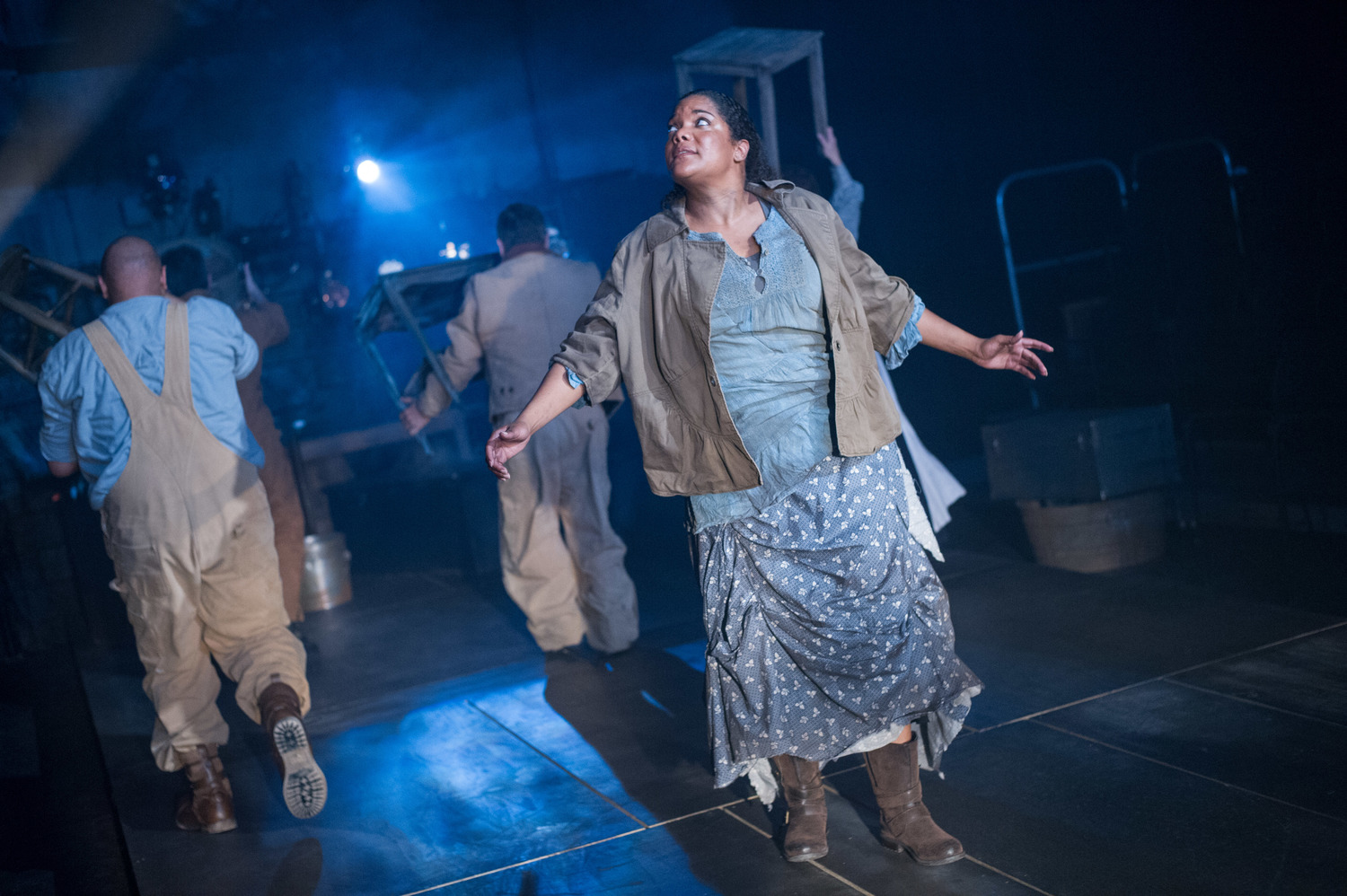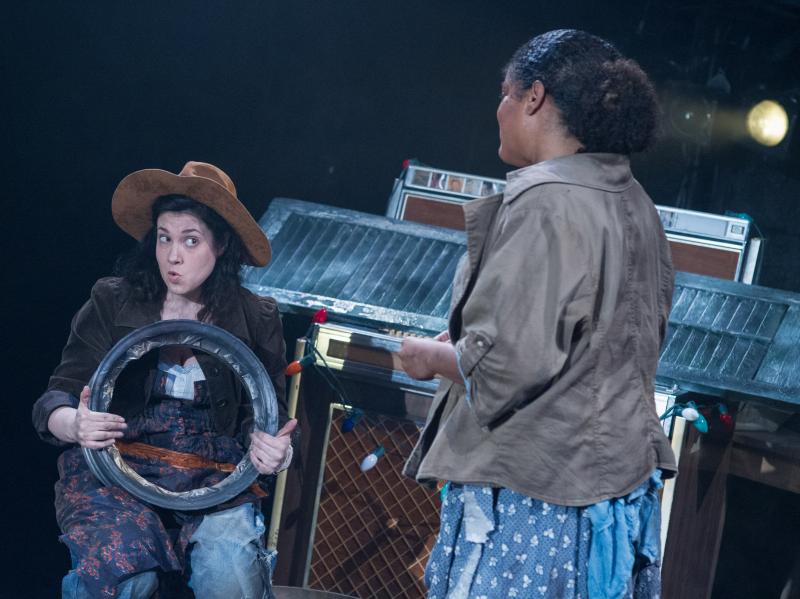Review: Theater Alliance's FLOOD CITY Gets Swept Away by Numerous Troubles

Photo by C. Stanley Photography.
The first five minutes of Theater Alliance's new production of Flood City are some of the most gripping that have graced a D.C. stage in the past year. As two women wrestle the torrential disaster which laid waste to Johnstown, Pennsylvania in 1889, the ensemble creates an immensely satisfying flood across the stage at the Anacostia Playhouse. Just when the dramatic storm is reaching a natural conclusion, the action is cut short by an announcement for the audience to turn off their phones. It's admittedly a humorous turn to the scene but it sets up a dangerous precedent for the remainder of the production: almost every scene is cut short just as it starts to settle into a groove. The result is two hours of wading through a black comedy that can't settle on a pace, tonality, or even a central theme.
As the story proper begins, the citizens of Johnstown are attempting to piece themselves back together after the devastating flood. Two women, Val (Lolita Marie) and Stacey (Kari Ginsburg) take stock of everyone and everything they lost overnight. As each scramble around the stage to best understand how the recent flood has altered their existence, Clive (Ryan Tumulty) wanders onstage with a pipe jutting out of his skull-an effect which is as jarringly disturbing as it sounds. These three demonstrate the various ways people respond to tragedy: Val by searching for connection, Stacey by capitalizing on opportunity, and Clive by striving for self-preservation. Each of their attempts at reconstruction are fairly compelling but the plot jumps around too much between the three protagonists and an ensemble of supporting characters who fill out a stereotypical slate: an incompetent guard, a well-meaning (but mildly offensive) nurse, and an opportunistic photojournalist.
Thinly written secondary characters are forgivable. A poorly executed time travel motif is less so. Almost everything in the first half of Flood City is grounded in reality and authentic emotions. When the second half of the story employs a time travel element it comes from so far out in left field that barely any audience members could control their looks of confusion and surprise. This decision seemed to be designed to underline some sort of central theme to the production: that companies (like the steel mill which contributed to the flooding in Johnstown) are corrupt and will cause harm to the average American. Unfortunately, there seems to be a contradictory line of these corporations bringing structure and order to communities which seems counterintuitive to that point. Perhaps the tone was meant to be satiric in those moments but the performance as presented at Anacostia Playhouse did not fully execute this theme.
While the script and performances fumble a little, the technical elements for Flood City consistently reach inspirational heights. Walking into the theater space of the Anacostia Playhouse is a thrilling moment. Thick fog and theatrical haze fills the air, creating a post-rain atmosphere that lingers throughout the entire production. Andrew Cohen's set design (dressed skillfully by Patti Kalil) gives a versatile play space for the ensemble. Thick wooden boards establish a space in the center of the room as found objects such as doors, desks, barrels and boxes serve as walkways and platforms and heighten the feel of being in a post-flood Johnstown. Couple this scenic decoration with the runway-style stage (with audience members flanking the play space on either side) and the immersive experience is enough to keep any audience member's attention even during the slowest times.

Photo by C. Stanley Photography.
The only aspects of the production design that feel less than perfect come from the costuming and sound design. Kelsey Hunt's costumes excel in the 1800s time period in which Flood City begins. When the show transitions to the 20th century, however, there's lacking inspiration in the design as the costumes lose out on some of the layers and textures which make the first half of the show more exciting. A similar disconnect is seen with Matthew M. Nielson's sound design and music composition. There are so many interesting music cues in the first half of the production, but when a modern soundtrack takes over as time travel happens, a lot of what made the sound interesting is abandoned. Additionally, there were several moments throughout the night where the volume of the sound effects drowned out the actors' lines.
Director Jenna Duncan does a serviceable job in bringing Gabrielle Reisman's script to life, but she is unable to elevate the script beyond what one would read on the page. Plot holes and unsuccessful themes/metaphors are inevitable in almost every script. The best directors are able to accent the positive elements while highlighting the negatives and, unfortunately, this is unable to be said about Flood City.
As a visual and technical production, Flood City is a success. Despite the flaws, the first five minutes of the production might just be enough to say this production is worth seeing. If the subsequent two hours were as compelling it would be an easier sell. At the end of the day, however, Flood City's best qualities might just be swept away by the problems its script and execution provide.
Theater Alliance's Flood City runs approximately two hours with one intermission and plays through June 17 at the Anacostia Playhouse. For information and tickets, click here.

Sam Abney is a Washington, D.C. based arts professional. A native of Arizona, he has happily made D.C. his new home. Sam is a graduate from George Mason University with a degree in Communication and currently works for Arena Stage as a member of their Development team. He is a life-long lover of theater and is excited about sharing his passion with as many people as possible.
To stay up-to-date on reviews from Sam, click here and subscribe to alerts.
Reader Reviews

Videos
